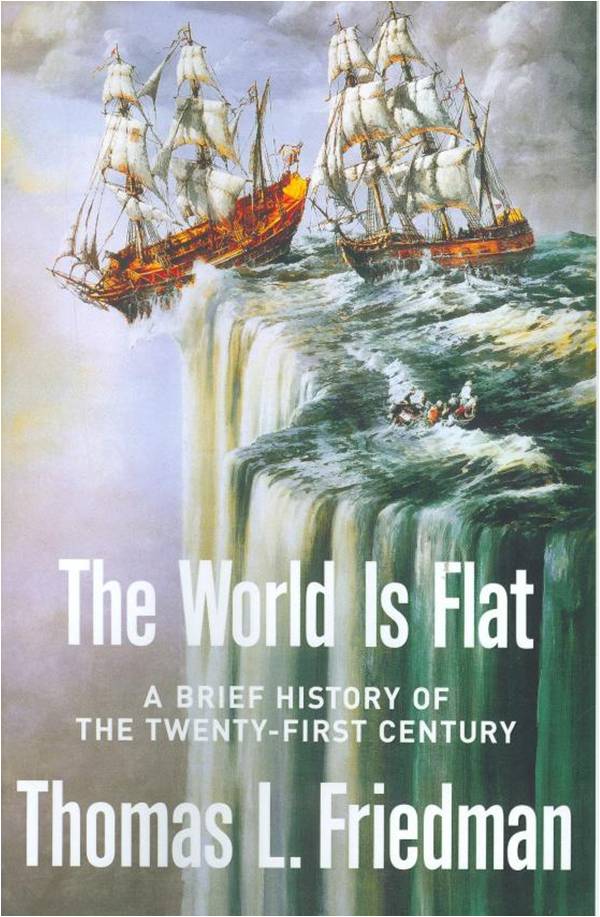

I just realized that April 5 was the 20th anniversary of the publishing of the bestseller The World Is Flat: A Brief History of the Twenty-first Century by fellow Minnesotan Tom Friedman. I read it at the time and it captured my imagination in many ways: how technology was democratizing opportunity for people across the world, across industries, across professions. If I were to summarize it in a meme (at the time), it would’ve been like: hey, look, now anyone with a “smartphone” (Blackberry) can be a freelance journalist! Not to poke fun, though: we really were waking up to the new era being ushered in by these “convergence devices” in our pockets1.
To his credit Friedman called a number of things pretty correctly:
I know: hindsight is 20/20, but it’s worth pointing out that there are certain things that are too idealistic in Friedman’s framework: the kinds of things that should happen according to the models you study in Econ 101; but that in reality are more complex.
I cited his piece in the borderless capital point, but Pankaj Ghemawat makes the argument that the globalization is a cool concept—and, ahem, sells books—but is far from a reality, save for specific segments of the population within a limited set of large world cities.
So where does this leave us? The world became more interconnected as Friedman predicted thanks to our technological advancements, but the playing field wasn’t “flattened” so much as “contoured” with new peaks of opportunity and valleys of exclusion. Because the distribution of the benefits of tech innovation has everything to do with non-technological factors: our institutions, power structures, tribal tendencies, etc.
So the question now becomes: Is it different this time: can AI really flatten the world? The optimistic view says yes, in certain respects: democratizing expertise and capabilities that were once the province of educated elites and/or the firms with the biggest balance sheets. But when you consider that 90% of AI research funding concentrated in just eight countries7, I think I’ll put my chip on us heading for another reconfiguration rather than equalization: i.e., those with access to computing resources, training data, and AI expertise being well-positioned to gain advantages that may prove significant (i.e. economist David Autor’s “superstar effects” where the most advantaged actors capture disproportionate benefits while others face displacement).
And what about more radical visions like Balaji Srinivasan’s Network State concept—digital communities/societies based on shared values rather than geography? Fascinating idea, Perhaps it could gain some traction in pockets, but my guess is it’s hard to scale (as hard or harder than scaling the cryptocurrency that undergirds it).
Twenty years after Friedman’s optimistic vision, we can say that technology creates potential pathways, but all the human stuff (our institutions, power structures) and market inefficiencies determine which paths actually get taken.
The world isn’t flat; it’s the proverbial waterbed where you press down on one spot and watch a bulge appear somewhere else.
— ᴘ. ᴍ. ʙ.
I can’t remember where I read it—but I wish I could because I think about it a lot—that one of the early decades in the 19th century was obsessed with futurism and futuristic technology (flying cars, and robots doing all of our chores, etc.—real Jetson’s stuff), and almost none of it had come true…or let’s say none of it had fully lived up to the dream. And the one invention that is mind-blowing and yet wasn’t predicted was the world’s information accessible from a device that lives in our pocket. That much power…and now with astounding ubiquity…and this connectedness has provided a foundation for amazing things to happen. ↩
United Nations Conference on Trade and Development, “Digital Economy Report 2021: Cross-Border Data Flows and Development: For Whom the Data Flow” (Geneva: UNCTAD, 2021). ↩
This is where Chris Dixon’s Read Write Own does a good job of connecting the dots, because shortly after this World Is Flat era the smartphones got even better (not just cameras for freelance journalism) and you had individuals participating in markets on top of web 2.0 platforms (e.g., Uber), which seemed great. And it was only years later when the venture funding ran out and the “take rates” squeezed both the demand and supply sides of something like ridesharing that we wake up to the fact that this isn’t the answer. Network operator (Uber Corp.) wins; the network participants (drivers) get kind of screwed. ↩
Influencer Marketing Hub, “The Creator Economy Report 2021: How Influencers Have Transformed Modern Marketing” (Copenhagen: Influencer Marketing Hub, 2021). https://influencermarketinghub.com/creator-economy-report/. ↩
Pankaj Ghemawat, “Why the World Isn’t Flat,” Foreign Policy 159 (2007): 54-60. ↩
Organisation for Economic Co-operation and Development, “Bridging the Rural Digital Divide,” OECD Digital Economy Papers, no. 265 (Paris: OECD Publishing, February 23, 2018). https://doi.org/10.1787/852bd3b9-en. ↩
Stanford University Human-Centered Artificial Intelligence, “Artificial Intelligence Index Report 2023” (Stanford, CA: Stanford University, 2023). ↩
First published: 2025-04-28 | tweet | cast | subscribe